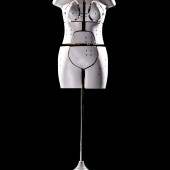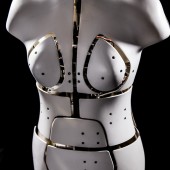
| THE AWARD |
| CATEGORIES |
| REGISTRATION |
| SUBMIT YOUR WORK |
| ENTRY INSTRUCTIONS |
| TERMS & CONDITIONS |
| PUBLICATIONS |
| DATES & FEES |
| METHODOLOGY |
| CONTACT |
| WINNERS |
| PRESS ROOM |
| GET INVOLVED |
| DESIGN PRIZE |
| DESIGN STORE |
| THE AWARD | JURY | CATEGORIES | REGISTRATION | PRESS | WINNERS | PUBLICATIONS | ENTRY INSTRUCTIONS |
I.dummy Innovative Fitting System by Allan C.K. Chan |
Home > Winners > Design #36778 >Interview |
 |
|
FS: What is the main principle, idea and inspiration behind your design?
AC: The i.Dummy project was conceived 5 years ago by Dr. Chan Chee Kooi, Allan of the Institute of Textiles & Clothing, The Hong Kong Polytechnic University. This was done as dummies are vitally used in the fashion industry for design and fitting and they are often available in single size and shape. Even when they are billed as a certain size, their shape and physical profiles can be variedly different. Coupled with various differences of many ethnicities, the finding of a dummy that can adequately represent the “person” has remains difficult.
FS: What has been your main focus in designing this work? Especially what did you want to achieve?
AC: The main focus is to design and develop a robotic mannequin that can mimic bodily profiles of different sizes of dummies for the global fashion industry.
FS: What are your future plans for this award winning design?
AC: The future plan is to propagate the technology and knowhow to other mannequin designs such as the male figure lower body, plus-sizes, and even children’s i.Dummies.
FS: How long did it take you to design this particular concept?
AC: It was conceived years ago, but the parts were not suitable then. This successful invention saw light after 4 years of dedicated research.
FS: Why did you design this particular concept? Was this design commissioned or did you decide to pursuit an inspiration?
AC: It was in a pursuit of an inspiration and to prove the concept works. It worked!
FS: Is your design being produced or used by another company, or do you plan to sell or lease the production rights or do you intent to produce your work yourself?
AC: The design is licensed for production and sales to a start-up company.
FS: What made you design this particular type of work?
AC: I have been a practitioner in the fashion industry for 30 years and I know many of the fixed sized dummies are not correct and costly too.
FS: Where there any other designs and/or designers that helped the influence the design of your work?
AC: Not really.
FS: Who is the target customer for his design?
AC: The target customers are Designers, Buying Office, Trading Offices, Factories and Retailers, anyone working in the Fashion supply Chain who has to do apparel fitting.
FS: What sets this design apart from other similar or resembling concepts?
AC: It is totally adjustable, unlike those in the market which are fixed.
FS: How did you come up with the name for this design? What does it mean?
AC: Various options came about, names mostly. However, since the mannequin is called “dummy” in the industry, naturally, the addition of an “i” will signify its “intelligence” and "interactiveness".
FS: Which design tools did you use when you were working on this project?
AC: Solidworks and CAD software.
FS: What is the most unique aspect of your design?
AC: Despite its change in sizes, it still looks like the everyday lady?
FS: Who did you collaborate with for this design? Did you work with people with technical / specialized skills?
AC: Yes, skills in mechatronics and software programming
FS: What is the role of technology in this particular design?
AC: It drives dimension changes, produces panel designs that culminated into an invention of an entire new product.
FS: Is your design influenced by data or analytical research in any way? What kind of research did you conduct for making this design?
AC: Anthropometric studies and size systems of national standards, scanned images of 3D scanners bought from third party together with those from our 3D scanner laboratory
FS: What are some of the challenges you faced during the design/realization of your concept?
AC: Getting the right person with the required expertise to work is most difficult, and once getting him, he may not know the ins and outs of the apparel industry in particular to the fit of clothing. The machining of mechanical parts is also challenging with countless modification along the way.
FS: How did you decide to submit your design to an international design competition?
AC: Good design has to be shared and made known to the world. An international design competition as a springboard can do this.
FS: What did you learn or how did you improve yourself during the designing of this work?
AC: Concept is one thing, realization is another. There are many unseen or un-thought off problems that can happen now and then, so it was learning along the way. The experience is good and future work will be less troublesome, because the lessons learned becomes valuable.
FS: Any other things you would like to cover that have not been covered in these questions?
AC: Funding is an important element of any research. I got turned down a good number of times, even one cited, “it will never work”. He/she was wrong!
FS: Thank you for providing us with this opportunity to interview you.
A' Design Award and Competitions grants rights to press members and bloggers to use parts of this interview. This interview is provided as it is; DesignPRWire and A' Design Award and Competitions cannot be held responsible for the answers given by participating designers.
| SOCIAL |
| + Add to Likes / Favorites | Send to My Email | Comment | View Press-Release |





